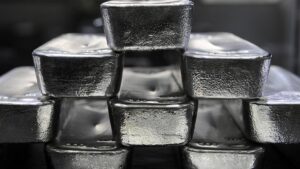Ten Bagger: Manganese back on the menu as investors feast on Black Canyon

The high grade hits at Black Canyon's Wandanya have investors excited about manganese again. Pic: Supplied/Stockhead
Welcome to Ten-Bagger, where Lowell Resources Fund chief investment officer John Forwood gives us his take on a sector of the ASX resources market full of value.
This month, John tells us about a manganese explorer emerging on the radar for investors thanks to its high grade drill hits.
Manganese is a key commodity feeding steel and, to a much lesser extent, battery supply chains.
For years its price has fluctuated wildly, with the scale of the market’s major exporters leaving it vulnerable to supply shocks.
One critical supplier, South32 (ASX:S32) and Anglo American’s 60-40 owned Groote-Eylandt Mining Company off the coast of the Northern Territory of Australia, showed how fragile markets could be after a cyclone in March 2024 knocked out key port infrastructure.
Exports only resumed in May with the long-term absence of the high quality GEMCO product sending average manganese prices for last year between 16-18% higher across a range of product grades.
Yet larger, and more lasting storms could be brewing for manganese supply, particularly of the high grade variety.
GEMCO is dealing with its impending mortality. Operating since 1964, its mine life is now in the single digits.
Woodie Woodie, the long-standing operation in WA’s Pilbara now run by Chinese-controlled ConsMin is getting on, with some reports putting stripping ratios there in the order of 20:1 and above.
And over in West Africa’s Gabon, which exports a 45.5% lump product representing 23% of the seaborne trade, its government has proposed a plan to phase out exports in a bid to force producers like France’s Eramet to upscale domestic downstream processing plants.
“Gabon is the world’s second largest supplier, exporting 7.03Mt in 2024, representing 23% of world trade. The country mines high quality (over 40% Mn) oxide ore suitable for both the production of ferroalloys and the manufacture of battery components,” analysts from Project Blue noted last month.
“The ore exports ban will affect Chinese consumers who rely on blending ore from various sources, as well as Eramet’s own plants in Norway and France.”
Opportunity abounds
That means any significant new high-grade manganese discovery could be treated very warmly indeed by both customers and investors.
“GEMCO has recently come back online and that’s 10 to 15% of the global market,” Lowell Resources Fund (ASX:LRT) chief investment officer John Forwood said.
“But A, it won’t last forever and B the product grade is ~43% concentrate, but actually the in situ grade is a hell of a lot lower. I’ve heard it’s about 21%.
“The other thing to note on the supply side is Gabon, which is the second largest producer of manganese in the world, has said from 2029 it’s not going to allow export of any unrefined manganese.
“It’s trying to do what Indonesia did with nickel in terms of value add to its raw mineral products. If that happens that could be a price shock in the mid term.”
Historically there have been two main exposures to manganese on the ASX.
South32 is one, though GEMCO is buried within a diversified portfolio leveraged more to aluminium, base metals like copper and zinc and, until recently, met coal.
Jupiter Mines (ASX:JMS) is a stable producer of lower grade manganese from its half-owned Tshipi mine in South Africa, but could find itself in takeover territory with South African-based Exxaro Resources making a play for its JV partner Ntsimbintle Mining and taking a strategic stake in JMS.
Stellantis and GM sponsored Element 25 (ASX:E25) is trying to take low grade manganese from its Butcherbird deposit in the Pilbara and process it into battery grade high purity manganese sulphate at a proposed plant in Louisiana.
Firebird Metals (ASX:FRB) is aiming to do something similar with its Oakover deposit, but with Chinese partners at an industrial park in Jinshi, Hunan Province, which will initially use high grade Gabonese ore from Eramet as a feedstock.
Also operating in the Pilbara is Black Canyon (ASX:BCA) which, like E25 and Firebird, owns a large low grade orebody at Balfour consisting of 314Mt at 10.4% Mn – WA’s largest by tonnage.
But it’s the company’s higher grade discovery at the pre-resource Wandanya that has fund managers like Forwood interested and the ~$23m company’s shares up 157% YTD.
Wandanya
Forwood says Wandanya has some similarities to Woodie Woodie, which sits just 80km to the north.
But it has some key differences. One of those is the high strip ratio the vintage Woodie Woodie mine now operated at.
“Whereas Wandanya in the grade could be similar, the strip ratio is almost definitely going to be very low. It could be less than five to one, so mining costs should be pretty attractive,” he told Stockhead.
Grades from drilling at Wandanya have clocked in at between 29-31% Mn, well above those seen in the Balfour field.
While a scoping study estimated Balfour could be upgraded to a Mn concentrate of 35% Mn, similar to South African mines like Tshipi, early testwork on material from Wandanya has upgraded the material to a premium 48-50%.
There’s also a high grade hematite iron ore zone sitting above the manganese horizon, with Hole WDRC057 from the most recent RC drill program there striking an intersection of 12m at 60.1% Fe from 5m including 7m at 64.2% Fe from 7m.
BCA said the results supported the logging of high grade iron mineralisation over hundreds of metres of strike, remaining open to the north.
Manganese mineralisation has been mapped for at least 2km open to the northand east, with assays from 98 drill holes still to come in over the next couple months and drilling expected to resume in August.
“It’s very early days in terms of the discovery, but they have intersected some really attractive grades that are much higher than what might be in situ in Groote Eylandt,” Forwood said.
“If that’s borne out, I don’t think Wandanya needs to wait for Groote Eylandt to start coming off stream.”
“It could have some pretty attractive economics, particularly as it looks like there is a high-grade iron ore zone which might fall partly within the same pit as the high grade manganese zone.
“Your waist-stripping ratio comes right down if some of that non-manganese material is actually high-grade iron ore and you might end up with an extremely low operating cost after byproduct credits.”
The views, information, or opinions expressed in the interviews in this article are solely those of the interviewees and do not represent the views of Stockhead. Stockhead does not provide, endorse or otherwise assume responsibility for any financial product advice contained in this article.
UNLOCK INSIGHTS
Discover the untold stories of emerging ASX stocks.
Daily news and expert analysis, it's free to subscribe.
By proceeding, you confirm you understand that we handle personal information in accordance with our Privacy Policy.








